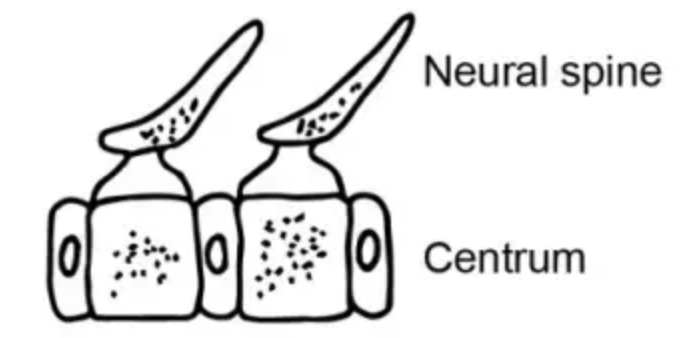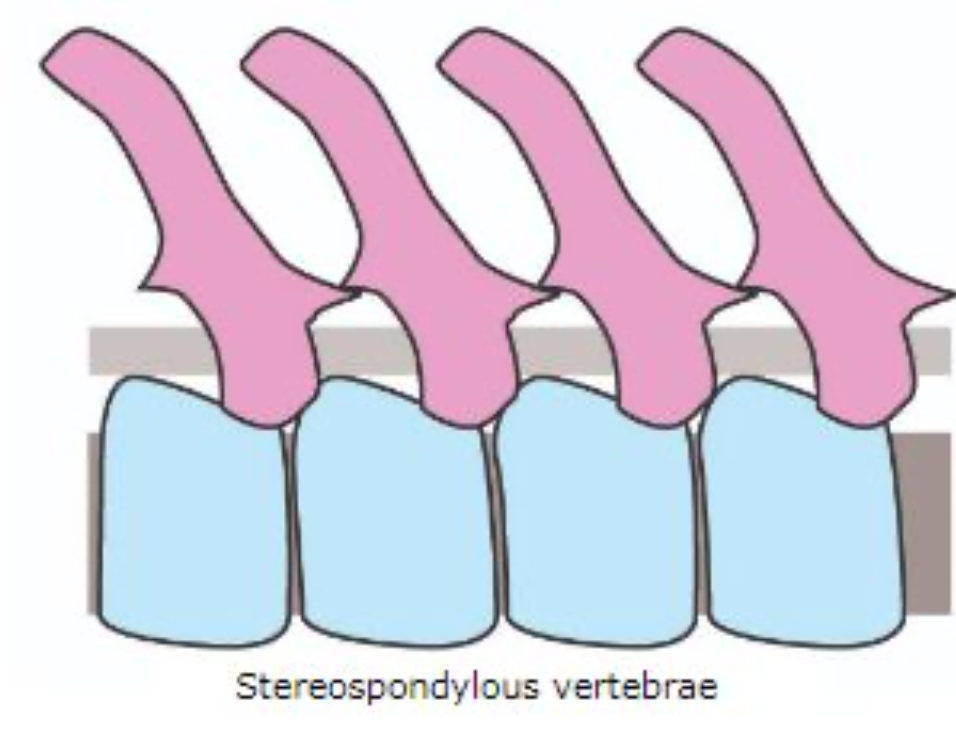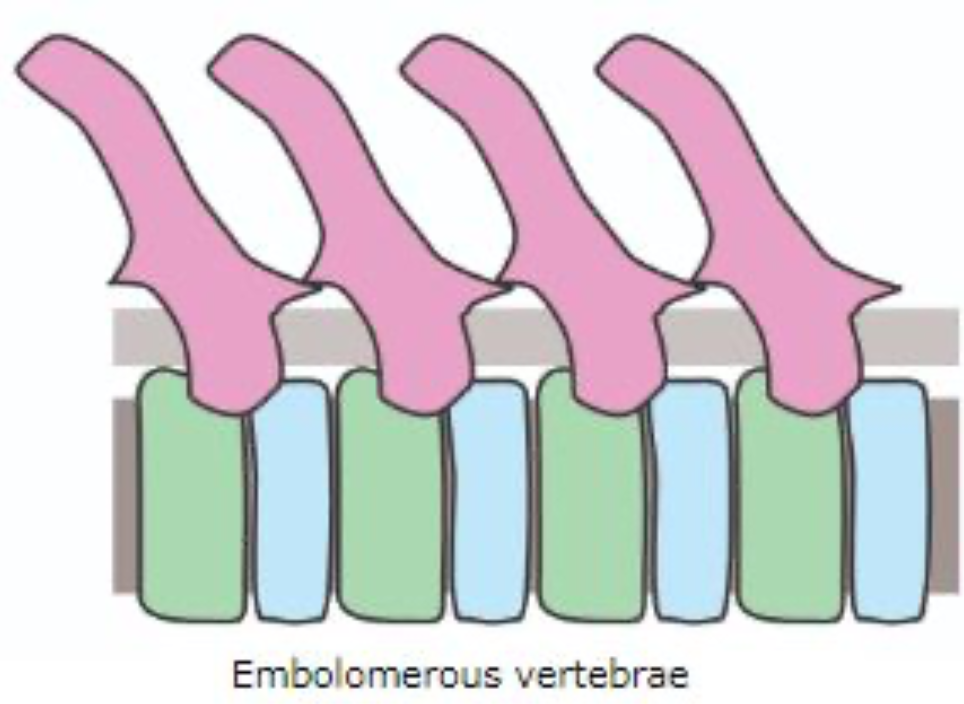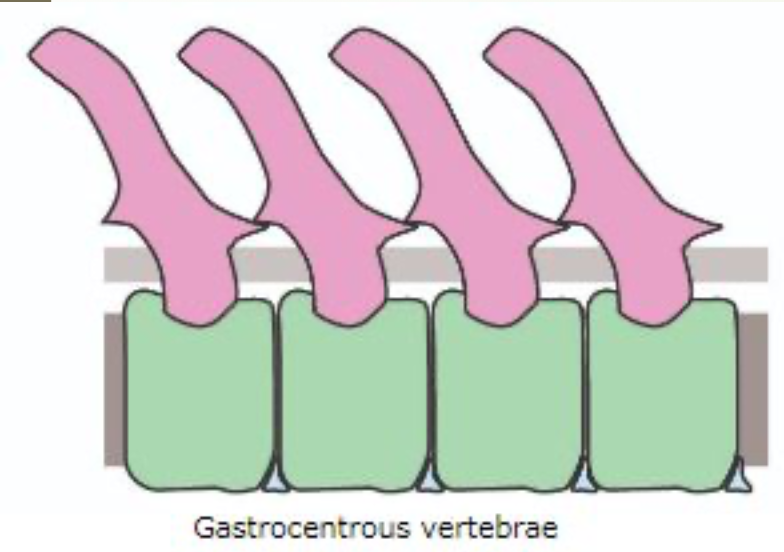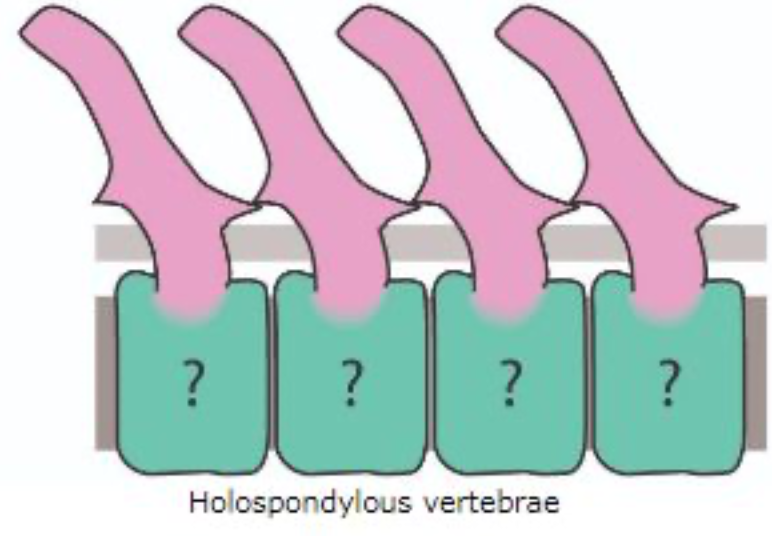Comparative Features of the Vertebrae, Ribs, and Sterna
Vertebral Column
NOTOCHORD
Primitive Axial Skeleton — Replaced by vertebral column
Unsegmented, composed of dense, fibrous connective tissue
First skeletal element in embryo of chordates
VERTEBRAL COLUMN
Segmented (more/less flexible), arched rod flanked by axial musculature
Function — Suspends the trunk, Protects the spinal chord
CENTRUM
Ossification of notochord
Function — Anchor + support to arches
Elements — Intercentrum (cranial), Pleurocentrum (caudal)
INTERCENTRUM | Extinct Amphibians |
AMNIOTES | Amniotes |
Structures of the Centrum
ABSENT | Aspondyly |
SINGULAR | Monospondyly |
DOUBLED | Dispondyly |
Types of Centra Based on Shape
AMPHICOELUS | Concave (both ends) Limited motion (permitted in any direction) | Fishes, Apoda, Urodela |
|
OPISTHOCOELUS | Convex (Front), Concave (Back) Permit motion (any direction) | Salamanders, Parrots, Ungulates |
|
PROCOELUS | Concave (Front), Convex (Back) Permit motion (any direction) | Anurans, Modern Reptiles |
|
ACOELUS/ AMPHIPLATYAN | Can withstand compression, limits motion | Mammals |
|
HETEROCOELUS | Saddle-Shaped Allows vertical & lateral flexion Prevents rotation around axis of spine | Birds |
|
ARCHES
NEURAL ARCHES | Encloses long vertebral canal, occupied by spinal chord Protects neural tube |
HEMAL ARCHES | Inverted beneath centra of tail Houses caudal vessels Protect blood vessels |
PROCESSES (APOPHYSES)
DIAPOPHYSES | Transverse Processes Articulating points for ribs Attachment for muscles |
ZYGAPOPHYSES | Paired processes (articular surfaces; neural arches articulate) Prezygapophyses — Front Postzygapophyses — Rear/back |
PARAPOPHYSES | Lateral projections from centra (some tetrapods) Articulation site for bicipital rib |
PHYLOGENY OF VERTEBRA
RHACHITOMOUS | Present (earliest land vertebrates) Centra retains geometric relationships, but robust Articulates with one another, restricting the notochord |
|
STEREOSPONDYLOUS | Pleurocentra — Reduced/lost Intercentra — Spool-shaped |
|
EMBOLOMEROUS | Pleuro/Intercentra — Similar Gives each neural arch two spool-shaped centra |
|
GASTROCENTROUS | Present (amniotes & relatives) Pleurocentra — Enlarged, fused Intercentra — Reduced (small wedges) or lost |
|
HOLOSPONDYLOUS | Neural Arches, Centra — Ossify Origin of centrum is unknown (pleurocentrum, intercentrum, or both?) Notochord — Intervertebral discs |
|
AGNATHANS
Notochord — Persists
Lateral Neural Cartilages (skeletal elements; limited to tail region in hagfishes)
Dorsolateral Cartilaginous Plate — Single, longitudinal; perforated by foramina for spinal nerves
CHONDRICHTHYANS
Notochord — Present (adult vertebral column)
Centra — Chordal & perichordal cartilage; amphicoelus
Two types of vertebra
Trunk
Caudal (haemal arch & haemal spine)
Squalus — Have foramina for dorsal and ventral roots
Fibroelastic ligament — Connects neural spines along vertebral column
ACTINOPTERYGIANS
Vertebrae — Well-ossified
Centrum — Dumb-bell shaped vacuole
Porous cartilage-like material — Space between successive vertebrae
Supraneural bones — Neural spines; very tall, sometimes surmounted
SARCOPTERYGIANS
NO CENTRA — Dipnoans, chondrostei, coelocanth
NOTOCHORD — Present, unconstricted; contains little cartilage/bone (Basidorsal, Basiventral, Interdorsal, Intervertebral Cartilage)
EVOLUTION OF TETRAPOD VERTEBRAE
Rhipidistian + early labyrinthodants — Consists of several bones per segment
HYPOCENTRUM | Median, U-shaped anterior bone Cradles notochord |
PLEUROCENTRA | Small wedges of bone, overlying the notochord dorsolaterally Left and right laminae of bone, lateral to spinal chord Collectively provides neural arch |
NOTOCHORD | Continuous throughout body; constricted at level of hypocentrum |
Rhachitomi — Large intercentrum, small pleurocentra
Stereospondyli — Retains intercentrum
Embolomeri — Increased size of pleurocentrum to size of intercentrum
Amniotes — Enlarged pleurocentrum to near/complete exclusion of intercentrum
REGIONAL SPECIALIZATION IN TETRAPOD COLUMNS
CERVICAL VERTEBRA | Development of mobile joint between first vertebra & skull Shortening/eliminating ribs Increasing mobility of intervetebral joints |
THORACIC VERTEBRA | Presence of long ribs in anterior portion of trunk |
LUMBAR VERTEBRA | Immediately after thoracic Supports abdominal cavity |
SACRAL VERTEBRA | Supports stress transmitted to pelvic girdle |
CAUDAL VERTEBRA | Tail Vertebra |
TYPES OF CERVICAL VERTEBRA
AMPHIBIANS | Single cervical vertebra Lacks processes, bears facets Permits limited rocking of skull |
AMNIOTES (ATLAS) | Ringlike (centrum is missing) Centrum — Odontoid process of axis; held in place by transverse atlantal ligament Reduction/absence of zygapophyses Sphenodon — Chondrifies & unites with axis |
PROATLAS | Resembles neural arch, derived from pair of bilateral cartilaginous blastemas (i.e., crocodilians, sphenodon, insectivorous spiny hedgehogs) |
TURTLES | Ball-of-Socket joint — Head and neck retracts into shell 8 cervical vertebrae |
BIRDS | Exceptional flexibility — configuration of vertebra; (Right-Left convexity; Dorsoventral concavity) Increased number of cervical vertebra (Commonly 12; 25 in swans) |
MAMMALS | 7 cervical vertebrae
Length of centra, not number — Length in mammals |
SACRAL VERTEBRAE
Stout transverse process
AMPHIBIANS | 1 |
LIVING REPTILES | (Living reptiles, birds, opossums) 2 |
MAMMALS | 3-5 Perissodactyls — 8 Edentates — 13 |
SYNSACRUM
Fusion of thoracic, lumbars, sacral, few caudals with pelvic girdle (little flexibility)
Armadillos — 13 fused sacrals & caudals
CAUDAL VERTEBRAE
Early Tetrapods — 50 or more
Reduced to tail in modern mammals
Processes & Arches — Shorter, rudimentary
UROSTYLE
Anurans — Continuous elongated perichordal cartilage (base of tail); post-sacral vertebrae
AUTOTOMY
Regeneration of tail (lizards, salamader, tuatara); sheds part of tail to escape
PYGOSTYLE
Fusion of last caudals (skeleton of bird; tail)
COCCYX
Rudimentary — With transverse processes, lacks arches
Diminished in size, fused in apes & humans
VERTEBRAL FORMULA IN MAMMALS
SPECIES | CERVICAL | THORACIC | LUMBAR | SACRAL | CAUDAL |
Dog | 7 | 13 | 7 | 3 | 20-23 |
Cat | 7 | 13 | 7 | 2 | 20-23 |
Horse | 7 | 18 | 6 | 5 | 15-20 |
Cattle | 7 | 13 | 6 | 5 | 18-20 |
Sheep | 7 | 13 | 6-7 | 4 | 16-18 |
Goat | 7 | 13 | 7 | 4 | 12 |
Pig | 7 | 14-15 | 6-7 | 4 | 20-23 |
Chickens | 14 | 7 | 14 | 14 | 6 |
Human | 7 | 12 | 5 | 5 | 4 |
Elephant | 7 | 20 | 3 | 3 | 31 |
Giraffe | 7 | 14 | 6 | 4 | 20 |
Sloth | 9 | 16 | 3 | 6 | 11 |
Manatee | 6 | 17 | 25 |
Ribs
Articulate with vertebrae, extends into body wall; formed intersegmentally (scleroblasts) from two mesodermal somites (centra)
Gastralia (Abdominal Ribs) — Not ribs (reptiles), remnants of dermal exoskeleton
FISHES
Basal Actinopterygians, Telosts — Two sets of ribs (each vertebra)
DORSAL RIBS | Pas slateral into horizontal skeletogenous septum Separates epaxial & hypaxial muscles *Sharks — Only dorsal ribs |
VENTRAL RIBS | Develop in myosepta & arch ventral in lateral body, external to parietal peritoneum *Most fish (except perch) — Only ventral ribs |
Skates, Chimaeras, Teleosts, Agnathans — No ribs
TETRAPODS
Ribs — Associated with vertebrae, from atlas to base of tail; restricted in number, short ones ankylosed (stiffens); long ribs (anterior thoracic region) acquired anchorage (sternum)
Tetrapod ribs are homologous and bicipital—dorsal tuberculum (transverse process), ventral capitulum (hypocentrum)
CAPITULUM | Two adjacent demifacets (half-facets) Parapophysis (if present) Facet on single centrum Fused with tuberculum (crocodilians) |
TUBERCULUM | Reduced in size Fused with capitulum (crocodilians) |
THORACIC RIBS | Coastal — Adjacent to vertebrae Sternal — Ventral, articulates with sternum |
STERNAL RIBS | Remains cartilaginous (coastal ribs) |
AMPHIBIANS
Very short (anurans, urodeles)
Ankylosed (transverse process) in anurans
Ribs (burrow-dwelling apodans) are long
Anurans — Not bicipital
NONAVIAN REPTILES
Lizards & Crocodilians — Long ribs in trunk vertebrae, short ribs in neck
Sphenodon — Long ribs in trunk, ribs continue to tail
Geckos (ribs with every cervical vertebra)
*More specialized lizards lack atlas & axis
DRACO | Half-dozen or more posterior ribs are elongated Patagium — Can be rotated outward |
TURTLES | No cervical ribs, trunk ribs fused with coastal plates Sacral Ribs — Not fused with carapace, short with expanded distal ends ankylosed to ilium |
SNAKES | Long, curved ribs (second vertebra), continues to tail No sternum for rib attachment, ventral end of ribs have ligamentous connections with integumentary scutes Cobra — Long, curved ribs, can be rotated outward, folds of loose skin spread & inflate with air from lungs |
BIRDS
First two pairs of ribs — articulate with last two cervical vertebrae at base of neck with carinates (generally movable, lack sternal segment)
Thoracic Ribs — Next 5 pairs are thin, flat, broad, and have uncinate processes
Caudal Ribs — Ankylosed to synsacrum
MAMMALS
Confined in thorax
9 PAIRS | Whales |
24 PAIRS | Sloths |
12 PAIRS | Most common |
If more than 10 ribs are present, remaining are floating/not connected with sternum
Transverse Foramen — Fusion of transverse process and centra
Tetrapod Sternum
Tetrapod-only structure; predominantly found in amniotes (endochondral in origin)
Presence, size, anatomical relationship — Correlated with extent to forelimbs are employed in locomotion
Functions
Base against pectoral girdles and ribs are braced
Anatomical origin of ventral muscles of forelimb
Largest in flying animals, reduced/absent in tetrapods lacking forelimbs
Paired Mesenchymal — Unites, undergoes chondrogenesis
PRESTERNAL BLASTEMAS | Formation of manubrium |
SUPRASTERNAL BLASTEMAS | Formation of suprasternal ossicles |
AMPHIBIANS
Well-differentiated (anurans)
Necturus — More/less isolated nodules of cartilage associaed with linea alba caudal to coracoid cartilages of pectoral girdle; sternal element in other salamanders at same location
Apodans — No trace of sternum
NONAVIAN REPTILES
Lizards — Agile climbers & rubbers have large shield-shaped sternum/cartilage (replacement bone)
Crocodilians — Simple, cartilaginous plate attached to precoracoid of pectoral girdle, continues caudally in mineralized fibrous membrane incorporating the gastralia
Turtles — No sternum
BIRDS
Sterna — Power flight birds developed enormous keel/carina where flight muscles are attached
MAMMALS
Composed of series of bony segments (strenebrae)
Sternebrae/xiphisternum — Cartilaginous/bony xiphoid process
Marine mammals — Only few ribs reach it, individual sternebrae tend to fuse



